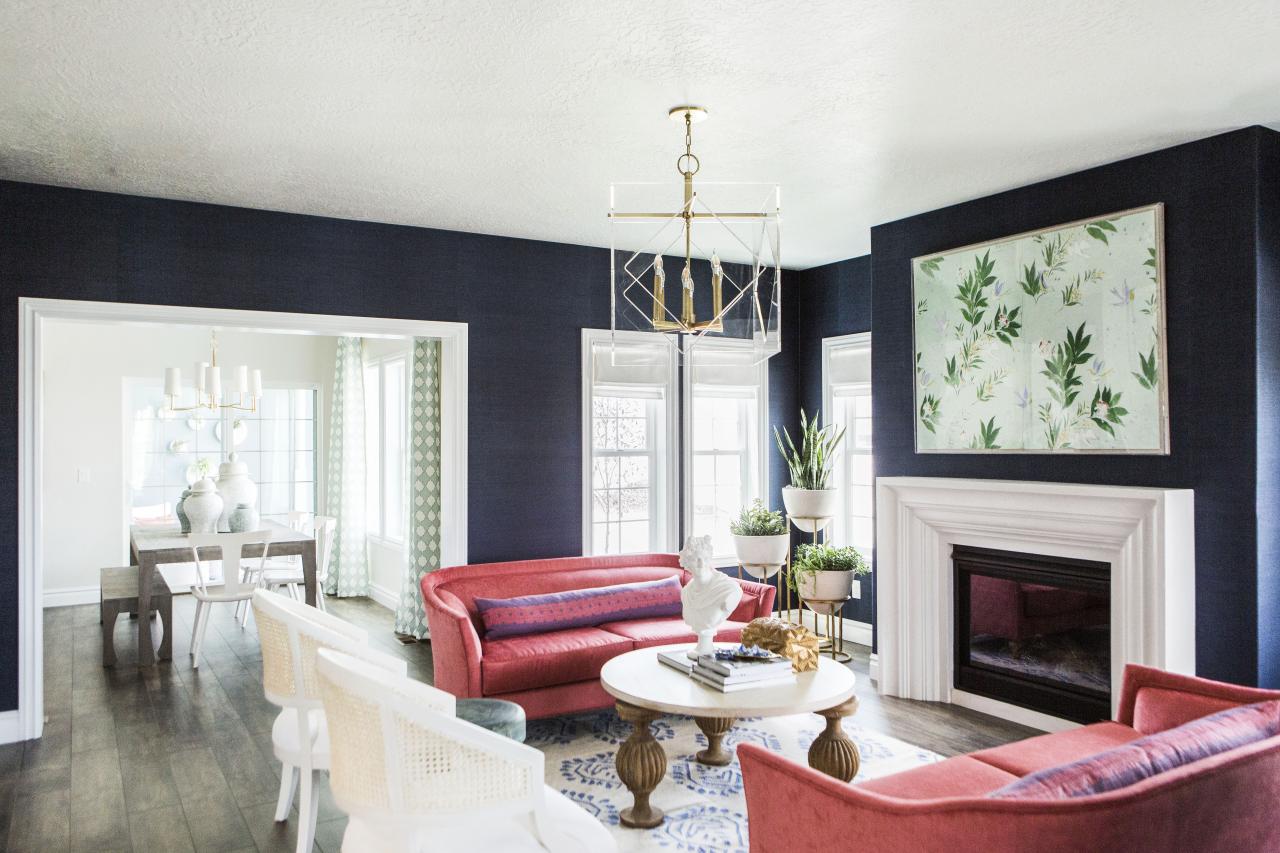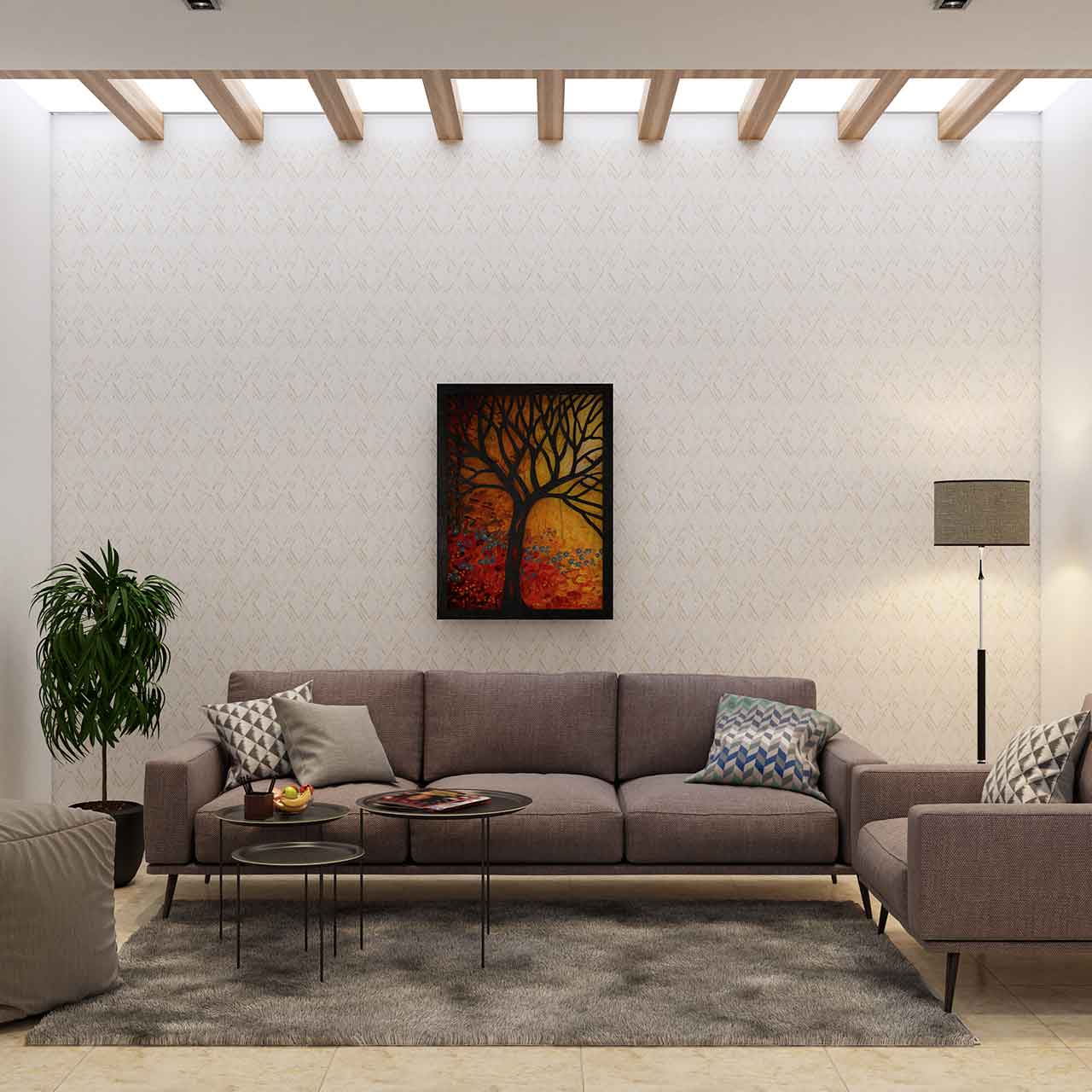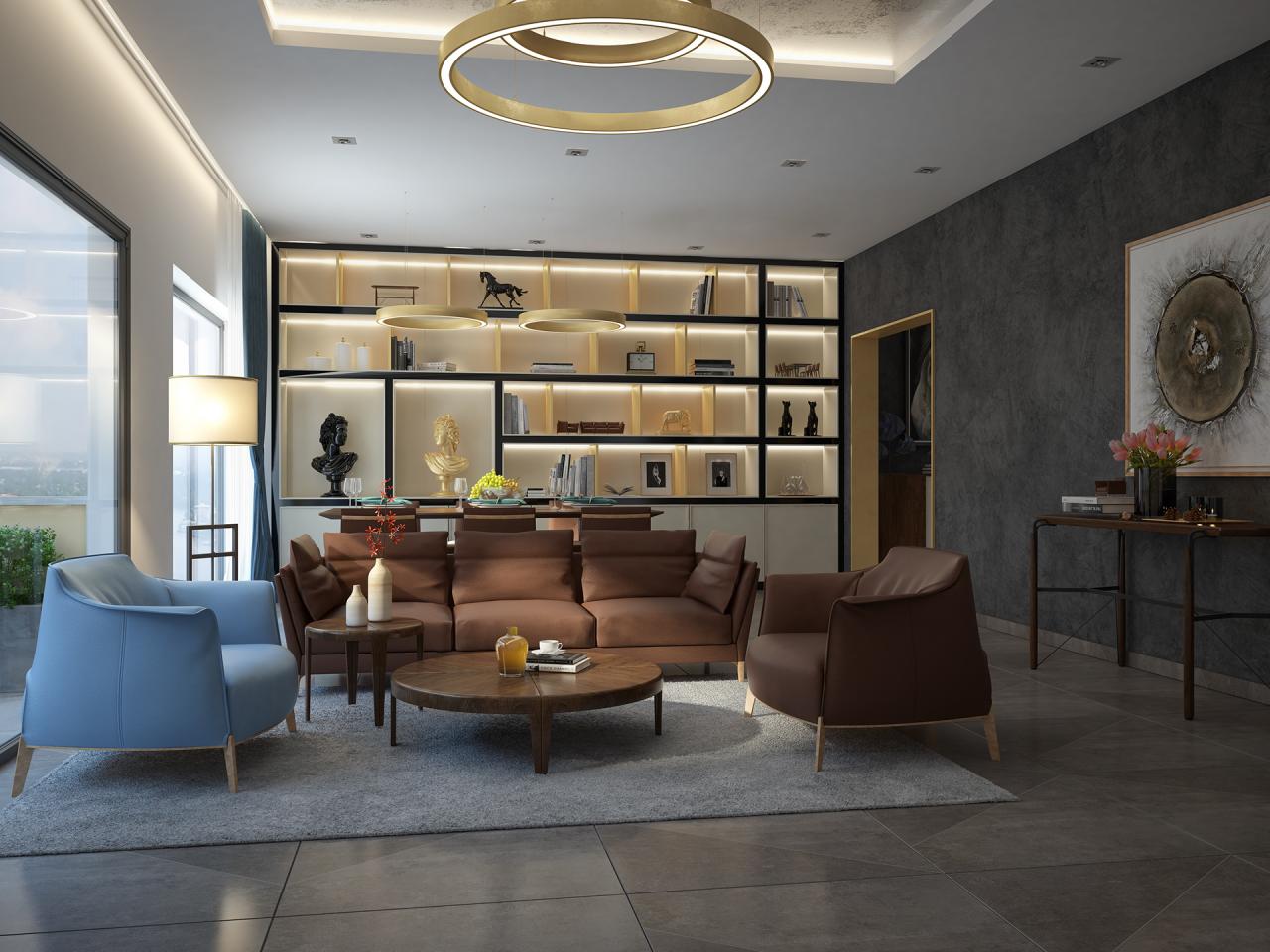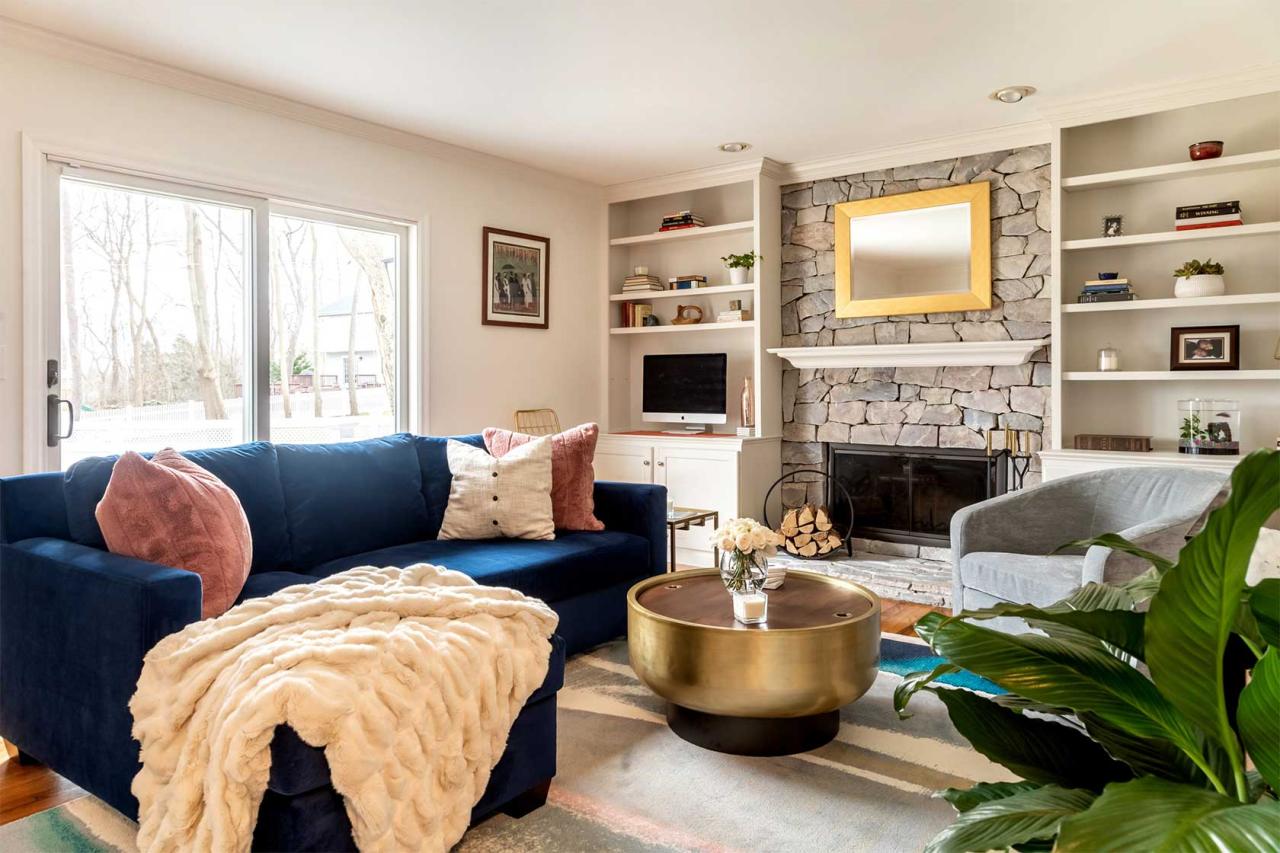Living room ideas are everywhere, but transforming your space into a haven of comfort and style requires a thoughtful approach. From furniture arrangement and color palettes to lighting and décor, every element plays a crucial role in creating the perfect ambiance. This guide dives deep into practical tips and creative inspiration to help you design a living room that reflects your personality and enhances your daily life.
Whether you’re aiming for minimalist chic, cozy bohemian vibes, or modern sophistication, we’ve got you covered with actionable advice and stunning visual concepts.
We’ll explore various furniture layouts optimized for different space sizes, delve into the psychology of color and its impact on mood, and illuminate the art of layered lighting to create the perfect atmosphere. You’ll discover how to strategically incorporate textures and accessories to add personality and visual interest, and explore clever storage solutions to keep your space clutter-free. Get ready to transform your living room from ordinary to extraordinary!
Living Room Furniture Arrangement: Living Room Ideas
Creating a functional and stylish living room, especially in a small space, requires careful consideration of furniture arrangement. The right layout can dramatically impact the room’s feel, maximizing both comfort and flow. Let’s explore several options to inspire your own design.
Small Space Living Room Arrangements
Optimizing space in a small living room is key. Below are three distinct arrangements, each designed for a 10ft x 12ft space (approximately 120 square feet), highlighting different functionalities. Remember, these are suggestions; adapt them to your specific needs and furniture dimensions.
Arrangement 1: The Cozy Corner
This arrangement prioritizes relaxation. A loveseat (5ft wide) is positioned against one wall, with a comfortable armchair (3ft wide) angled to create a conversational nook. A small coffee table (2ft square) sits between them. A narrow console table (3ft long) is placed against the opposite wall, providing extra surface area. This arrangement leaves ample floor space for movement.
Arrangement 2: The Efficient Layout
Revamping your living room? Consider incorporating this year’s hottest looks! Check out the best luxury home interior design trends 2024 for inspiration on creating a truly luxurious space. From statement furniture to bold color palettes, these trends offer a wealth of ideas to elevate your living room’s style and create a haven of comfort and sophistication.
This arrangement focuses on maximizing space. A sofa (7ft long) is placed against the longest wall, with a smaller armchair (2.5ft wide) perpendicular to it near a window. A slim rectangular coffee table (3ft x 1.5ft) sits in front of the sofa. This layout creates a clear pathway through the room.
Arrangement 3: The Multi-Functional Setup
This layout incorporates extra functionality. A small sofa bed (6ft long) serves as both seating and a guest bed. A small side table (1.5ft square) is placed next to the sofa bed. A floor lamp is positioned in a corner, providing additional lighting. This is ideal for small spaces where versatility is important.
Sectional Sofas vs. Individual Sofas
The choice between a sectional sofa and individual sofas significantly impacts a living room’s layout and functionality. Sectional sofas offer a cohesive look, perfect for creating a central seating area. However, they can be bulky and less adaptable to different room shapes. Individual sofas, on the other hand, offer more flexibility in arrangement and can be easier to move around.
They can be more costly overall than a single sectional.
Living Room Furniture Arrangement Styles
Different furniture arrangement styles reflect distinct design aesthetics. The table below highlights key characteristics of several popular styles.
| Style | Key Characteristics | Furniture Examples | Space Considerations |
|---|---|---|---|
| Traditional | Symmetrical layout, formal furniture, ornate details | Large sofas, armchairs, formal coffee tables, antique pieces | Requires ample space; often best suited for larger living rooms |
| Modern | Clean lines, minimalist design, functional pieces | Sleek sofas, modular furniture, simple coffee tables, contemporary art | Can work in smaller spaces with careful planning |
| Minimalist | Focus on essential pieces, neutral colors, open space | Low-profile furniture, multi-functional pieces, limited accessories | Ideal for smaller spaces; prioritizes functionality and simplicity |
| Eclectic | Mix of styles and textures, vibrant colors, unique pieces | Variety of furniture styles, vintage finds, bold artwork, patterned rugs | Can work in any size space, but requires careful curation to avoid clutter |
Living Room Color Palettes and Themes

Choosing the right color palette and theme for your living room is crucial in setting the overall mood and style of your home’s heart. The colors you choose will significantly impact how the space feels – from calming and serene to vibrant and energetic. Consider your personal style and the level of ambiance you wish to create before diving into the paint swatches.
Three Distinct Living Room Color Palettes
Color psychology plays a significant role in interior design. Different colors evoke different emotions and can dramatically alter the perceived size and atmosphere of a room. Here, we explore three distinct palettes to inspire your living room transformation.
Creating a stunning living room involves careful consideration of both aesthetics and functionality. The key is finding that perfect balance, much like the approach outlined in this article on balancing luxury and comfort in bedroom design , which emphasizes creating a relaxing sanctuary. Applying similar principles to your living room – prioritizing comfort without sacrificing style – will result in a space that’s both inviting and sophisticated.
1. Serene Neutrals: This palette centers around calming neutrals like creamy whites, soft greys, and warm beige. These colors create a sense of spaciousness and tranquility. Creamy white walls act as a blank canvas, allowing other elements to pop. Soft greys on upholstery add a touch of sophistication, while warm beige accents in rugs or throw pillows introduce warmth and comfort.
This palette is perfect for creating a relaxed and inviting atmosphere.
2. Vibrant Jewel Tones: For a bolder statement, consider a palette of rich jewel tones such as emerald green, sapphire blue, and ruby red. These deep, saturated colors add drama and luxury to a space. Use emerald green as an accent wall, pair sapphire blue with plush velvet furniture, and incorporate ruby red through decorative accessories. This palette is ideal for those who want a sophisticated and visually striking living room.
3. Earthy Naturals: This palette evokes a sense of connection to nature. It features earthy tones such as terracotta, olive green, and warm browns. These colors create a grounding and calming effect. Terracotta walls bring warmth and texture, while olive green accents in cushions and rugs add a touch of freshness.
Warm brown wooden furniture completes the look, creating a cozy and inviting atmosphere.
Bohemian Living Room Theme
This theme embraces a free-spirited, eclectic style. Color choices are rich and varied, incorporating warm terracotta, deep indigo, and sunny yellow. Materials include natural fibers like jute rugs, woven throws, and macrame wall hangings. Furniture styles are mismatched yet cohesive, featuring low-slung sofas, vintage armchairs, and handcrafted coffee tables. The overall effect is layered, textured, and inviting, reflecting a global aesthetic with a touch of bohemian flair.
Texture Incorporation in Living Room Design
The skillful use of texture adds depth and visual interest to any living room. Different textures create visual contrast and tactile appeal, enhancing the overall sensory experience.
Here are some examples of how different textures can be incorporated:
- Wood: A wooden coffee table paired with a plush velvet sofa creates a beautiful contrast of textures. A wooden wall feature adds warmth and character.
- Fabric: A variety of fabrics, such as linen, velvet, and cotton, can be used in cushions, throws, and curtains to add visual interest and tactile comfort.
- Metal: Metallic accents, such as a brass lamp or a chrome coffee table, can add a touch of glamour and sophistication. The sheen of metal contrasts beautifully with the softness of fabrics and the warmth of wood.
Living Room Lighting and Ambiance

Transforming your living room into a haven of comfort and style hinges significantly on the strategic implementation of lighting. It’s more than just illuminating the space; it’s about crafting an atmosphere that reflects your personality and enhances the overall aesthetic. The right lighting can amplify the beauty of your furniture, highlight architectural details, and set the perfect mood for relaxation or entertaining.Lighting design for a living room typically involves three key types: ambient, task, and accent lighting.
These work synergistically to create a layered and dynamic illumination scheme, far exceeding the capabilities of a single overhead fixture.
Layered Lighting Schemes for a Warm and Inviting Living Room
A well-designed layered lighting scheme allows for flexibility and control over the ambiance. By combining different types of lighting, you can adjust the mood to suit various activities and times of day. Think of it as orchestrating light, much like a conductor guides an orchestra.
- Ambient Lighting: The Foundation. This provides overall illumination for the room. A central ceiling fixture, such as a chandelier, recessed lights, or a stylish pendant lamp, forms the base layer. Consider a dimmer switch to control the brightness and create a softer glow for evening relaxation.
- Task Lighting: Functionality and Focus. This type of lighting targets specific areas where you need focused illumination. A floor lamp positioned next to a reading chair, a desk lamp on a side table, or under-cabinet lighting in a built-in shelving unit all serve this purpose. These lights are crucial for activities like reading, working, or crafting.
- Accent Lighting: Highlighting Features. Accent lighting is used to highlight architectural details or artwork. Picture lights above paintings, strategically placed spotlights on sculptures, or even LED strip lighting inside a built-in bookcase add depth and visual interest. This layer adds personality and showcases your cherished possessions.
The Impact of Natural Light and Maximizing its Use
Natural light is a powerful design element, offering a free and healthy source of illumination. It significantly impacts the mood and energy of a living room. Maximizing natural light not only reduces your reliance on artificial lighting but also creates a brighter, more airy, and welcoming space.To optimize natural light, consider these strategies:
- Maximize Window Exposure: Keep window treatments light and airy. Sheer curtains or blinds allow light to filter through while maintaining privacy. Avoid heavy drapes that block significant amounts of natural light, unless needed for heat insulation or darkness for sleeping.
- Strategic Furniture Placement: Avoid blocking windows with large pieces of furniture. Position seating to take advantage of the light, allowing it to wash over the room. A well-placed mirror can also help reflect natural light into darker corners.
- Light-Colored Walls and Decor: Light and neutral wall colors reflect natural light more effectively than darker shades. Similarly, light-colored furniture and rugs will help maintain brightness and spaciousness.
Living Room Decor and Accessories

Choosing the right décor and accessories can transform a living room from merely functional to truly inviting and stylish. These elements add personality, warmth, and visual interest, reflecting your unique style and creating a space you’ll love spending time in. The careful selection and placement of these items are key to achieving a cohesive and aesthetically pleasing living room.The strategic use of decorative accessories elevates the overall design of your living room.
They provide opportunities to inject color, texture, and personality, complementing the existing furniture and color palette. By understanding how these accessories interact with each other and the larger space, you can create a living room that is both visually stunning and comfortable.
Decorative Accessories and Their Uses
Decorative accessories play a crucial role in personalizing and enhancing a living room. They are the finishing touches that bring the room to life. Consider these key elements:
- Throw Pillows: These add pops of color, texture, and pattern. A mix of sizes and textures creates visual interest. For instance, a large velvet pillow in a jewel tone could be paired with smaller, patterned linen pillows for a luxurious yet eclectic feel.
- Throws and Blankets: These provide warmth and comfort, as well as adding textural depth. A chunky knit throw draped over the sofa introduces a cozy element, while a lightweight cotton throw can add a touch of elegance.
- Rugs: Rugs define areas within the room, anchor furniture groupings, and add warmth underfoot. A large area rug can tie together the seating arrangement, while a smaller rug can be used to define a reading nook.
- Artwork: Artwork is a powerful way to express your personality and create a focal point. Consider the scale and style of the artwork in relation to the room’s size and existing décor. A large abstract piece can be a statement piece, while a gallery wall of smaller prints can showcase a collection of interests.
- Plants: Adding greenery introduces life and vibrancy. Plants can soften hard lines and add a touch of nature. A large potted plant in a corner can create a focal point, while smaller plants can be arranged on shelves or side tables.
- Decorative Objects: These can include anything from vases and sculptures to books and candles. These items add personality and visual interest. A collection of vintage books displayed on a coffee table can add character, while a stylish vase with fresh flowers introduces a touch of elegance.
Creating a Visually Appealing Focal Point
A well-defined focal point draws the eye and anchors the entire room’s design. This could be a fireplace, a large window with a stunning view, or a carefully curated arrangement of furniture and accessories.To create a captivating focal point, consider the following:
- Furniture Arrangement: Arrange furniture to naturally draw attention to the focal point. For example, orient the seating arrangement towards a fireplace or a stunning piece of artwork.
- Artwork Placement: A large piece of artwork above a fireplace or sofa immediately becomes a focal point. Consider the scale of the artwork in relation to the surrounding furniture.
- Lighting: Highlight the focal point with strategic lighting. A spotlight on a piece of artwork or a dimmer switch controlling the lighting above a fireplace can emphasize its importance.
- Accessories: Use accessories to enhance the focal point. For example, place a decorative mirror opposite a window to reflect light and amplify the view, or arrange carefully chosen decorative objects on a mantelpiece above a fireplace.
Living Room Mood Board: Coastal Calm
Imagine a living room bathed in the soft hues of a coastal sunset. The color palette centers around calming blues and greens, punctuated by crisp whites and natural wood tones. The walls are painted a soft, sandy beige, providing a neutral backdrop. A large, textured area rug in shades of seafoam green and ivory anchors the space.The seating arrangement features a light grey linen sofa and two armchairs upholstered in a textured, natural-toned fabric.
Throw pillows in shades of turquoise, coral, and white add pops of color and texture. A chunky knit throw in a creamy white adds warmth and comfort. Artwork consists of framed prints of seascapes and abstract watercolors in muted blues and greens, creating a tranquil atmosphere. A large, woven basket holds a collection of throw blankets, adding a touch of rustic charm.
Natural elements such as driftwood sculptures and potted succulents further enhance the coastal theme. The lighting is soft and diffused, mimicking the gentle glow of a sunset, creating a peaceful and inviting atmosphere. The overall feeling is one of serene tranquility, evoking the calm and beauty of the coast.
Living Room Storage Solutions

A well-organized living room is a happy living room! Clutter can quickly overwhelm a space, detracting from its aesthetic appeal and overall comfort. Smart storage solutions are key to maintaining a stylish and functional living area, allowing you to keep belongings tucked away while maximizing space and showcasing your personal style. Let’s explore some effective ways to conquer living room clutter and create a haven of calm.
From discreet storage ottomans to stylish built-in shelving, there’s a perfect storage solution for every living room and every style. The key is to choose options that seamlessly integrate with your existing décor while providing ample space for your belongings. Consider the size of your living room, your storage needs, and your personal aesthetic when selecting the best fit for your home.
Built-in Shelving Units
Built-in shelving offers a sophisticated and highly customizable storage solution. They can be designed to fit seamlessly into any architectural style, maximizing space and providing ample room for books, decorative items, and media components. A well-designed built-in unit can become a focal point of the room, adding character and visual interest.
Consider this example of a built-in shelving unit designed for a modern living room:
| Dimension (cm) | Material | Functionality | Notes |
|---|---|---|---|
| Height: 210, Width: 240, Depth: 35 | White lacquered MDF, Walnut veneer shelves | Books, decorative items, media components | Top section features open shelving for display; lower section includes closed cabinets for storage. |
| Height: 40, Width: 120, Depth: 35 | Walnut veneer | Media console | Features cutouts for cable management and integrated lighting. |
| Height: 30, Width: 60, Depth: 35 | White lacquered MDF | Storage for smaller items | Two drawers for remote controls, etc. |
| Height: 10, Width: 240, Depth: 35 | Walnut veneer | Base | Provides a solid and visually appealing base for the entire unit. |
Ottomans with Storage
Ottomans with storage offer a practical and stylish solution for concealing clutter while providing extra seating. These versatile pieces can be used to store blankets, pillows, magazines, or other items, keeping them readily accessible yet out of sight. The choice of fabric and style can complement the overall living room design, making them a seamless addition to the space.
A large ottoman can even serve as a coffee table replacement, maximizing functionality in smaller living rooms.
Media Consoles, Living room ideas
Media consoles provide dedicated storage for entertainment equipment, keeping cords and wires organized and out of sight. These consoles come in a variety of styles and sizes, allowing you to choose one that complements your existing furniture. Many models include drawers, shelves, and cable management features to maximize functionality and minimize visual clutter. Choosing a media console with closed storage helps to maintain a clean and uncluttered look, hiding away remotes, game consoles, and other electronic accessories.
Open Shelving vs. Closed Storage
Open shelving and closed storage offer distinct advantages and disadvantages in a living room setting. Open shelving provides easy access to items and allows for the display of decorative objects, adding personality and visual interest. However, it requires more diligent organization to prevent the space from looking cluttered. Closed storage, on the other hand, helps to conceal clutter and maintain a clean aesthetic, but accessing items may require more effort.
The best choice depends on personal preferences, the amount of storage needed, and the overall style of the living room.